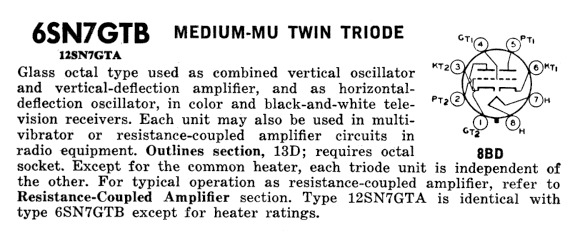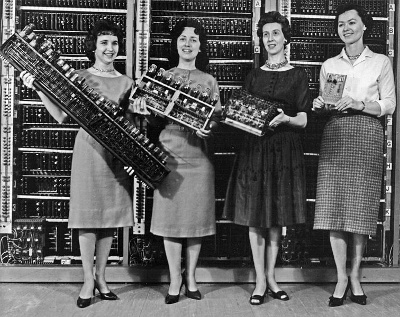ENIAC at 75
June 7, 2021
Significant
anniversaries are usually
celebrated in
festival, and this is true of the several
computer milestones that have finally reached their
golden (fifty year) anniversaries. One of these was the fifty year anniversary of the
BASIC programming language in 2014. I wrote about this in an
earlier article (Fifty Years of BASIC, May 19, 2014).[1-2] However, many recent anniversaries have come and gone without much notice because of the
COVID-19 pandemic. One of these was the 75th anniversary of the
ENIAC mainframe computer that became operational on February 15, 1946, at the
University of Pennsylvania (Philadelphia, Pennsylvania).[3-4] ENIAC was an
acronym for Electronic Numerical Integrator and Computer.

Left, the General Electric 225 mainframe computer on which BASIC was first deployed. Center, Thomas E. Kurtz (b. 1928). Right, John G. Kemeny (1926-1992). BASIC, an acronym for "Beginner's All-purpose Symbolic Instruction Code," was developed at Dartmouth College (Dartmouth, New Hampshire) by Kemeny and Kurtz. The development of BASIC began in 1963 with Kemeny's writing of a $300,000 proposal to the National Science Foundation for purchase of the General Electric 225 mainframe computer, and the subsequent development of a timesharing computer system for the Dartmouth campus. The GE 225 was soon replaced with a faster General Electric 235. BASIC was done with just 16k of 20 bit words. (Images from the Dartmouth College Flickr Website. Click for larger image.)
ENIAC was built from the best available
electronic components of that time; so, its
electronic switching was done using 17,468
vacuum tubes.[5] Today's computer circuits are built from
tens of billions of transistors a few tens of
nanometers in size. The vacuum tubes of ENIAC were about five
centimeters in length, and its bulk, which filled a 30
foot x 50 foot
room, was increased by the necessary
tube sockets, 70,000
resistors, 10,000
capacitors, and 7,200
crystal diodes.[5]
Vacuum tubes of the ENIAC period had a
lifetime of a few thousand hours, and
octogenarians will remember the need to replace a
burned-out tube in their vacuum tube
television receiver about once each year. Since the ENIAC had many tubes, several of these
commercial-grade tubes would burn-out daily, the failures normally occurring when the tube
filaments were cycled on and off. Eventually,
high-reliability tubes were
manufactured, and the
failure rate fell to a more manageable one tube every two days. With
statistics in play, there were runs of several days without a failure.

The start of the technical specification for the 6SN7 dual triode vacuum tube as it appears in the 1966 edition of the RCA Receiving Tube Manual. ENIAC used this common octal-base radio tube for its flip-flops, while other tube types were used in logic functions, and as line drivers for the long cable connections between rack assemblies. I'm old enough to have built circuits using this tube type, as scavenged from old television receivers. (Scan from my manual. Click for larger image.)
ENIAC was built at a time when
stored program computers weren't
possible, so it was
programmed using
plugboards. Eniac's operators would connect wires from point to point on the computer to complete the necessary
logic circuits for operation. There were times when two days were required to enter a program.[5] ENIAC had a 5,000 Hz
clock frequency, and it was capable of just a few hundred
calculations per second.[3]
ENIAC could multiply two, ten
digit numbers 357 times per second, and it required 150
kilowatts of
electrical power to operate, which works out to about a tenth watt per computation. Current
supercomputers can
perform as many as 10 billion
floating point operations per watt. ENIAC had an estimated performance of 0.00289
MIPS (millions of instructions per second); so, the
IBM Summit supercomputer at the
Oak Ridge National Laboratory (Oak Ridge, Tennessee), with a peak performance of 200,000 teraflops, is the equivalent of 69 trillion ENIACS.[3]
Hungarian-
American mathematician,
John von Neumann (1903-1957) had an early interest in computers, and he was a
consultant to a successor project to ENIAC, the 6,000 vacuum tube
EDVAC (Electronic Discrete Variable Automatic Computer), one of the first stored-program computers. ENIAC's computations were done in decimal, but EDVAC was a
binary computer.

Shrinking computer hardware, ENIAC (left) and successors. The smallest circuit board is from the BRLESC-I.
BRLESC used the letters K S N J F L instead of A B C D E F to represent the hexadecimal digits ten to fifteen. The mnemonic phrase "King Size Numbers Just For Laughs" was used to remember this notation.
This would be hard for me, since I still count A-F on my fingers.
(U.S. Army Photo 163-12-62, via Wikimedia Commons. Click for larger image.)
While on an extended train trip to
Los Alamos, New Mexico, von Neumann wrote an incomplete
First Draft of a Report on the EDVAC that described the stored-program concept, later known as the
von Neumann architecture. ENIAC's
inventors,
physicist,
John Mauchly (1907-1980), and
electrical engineer,
John Presper Eckert (1919-1995), were the inventors of EDVAC, which had an
ultrasonic serial memory of 1,000 34-bit
word and average
multiplication time of a little less than 3 milliseconds. They were also inventors of the stored-program concept. Unfortunately, distribution of von Neumann's report prevented Eckert and Mauchly from
patenting this invention.
The first significant
milestone in
numerical weather prediction was a
forecasting program implemented on ENIAC in 1950.[6] This forecast happened in real time; that is, it took an entire day to forecast the day's weather. In the decades since, computers have become much faster, and this allows computation of advanced
weather models that give us fairly accurate weather forecasts a week in advance.[7-8]

The precipitation forecast for July 10, 2012, to July 13, 2012, as computed by the North American Model.
Hurricane Emilia is at the bottom left corner, spinning towards the west.
The popular Linux graphical application, ImageMagick, was used in this rendering.
(From the National Centers for Environmental Information (NCEI) Website.)
While weather prediction is a noble goal, ENIAC was actually funded by the
US Army, which need a faster way to calculate
firing angles for
artillery during
World War II.[4] Such calculations require quite a few
parameters that include
temperature,
wind speed, and
humidity.[5] Such
differential calculus calculations, necessarily done manually at the time, took 40 hours.[4]
The public's misunderstanding of the functioning of
electronic brains like ENIAC is best typified in the
plot of
Spencer Tracy and
Katharine Hepburn's 1957
film,
Desk Set (
Walter Lang, Director). The Tracy character is the inventor of the mainframe computer, EMERAC, an acronym for Electromagnetic Memory and Research Arithmetical Calculator, obviously similar to the name ENIAC.
Much like today,
employees resisted deployment of the computer, since they thought that their jobs were in jeopardy, but that didn't happen.
IBM assisted in the production of Desk Set, and some critics have called the movie an IBM
propaganda piece with the message that computers won't take your job. EMERAC, which looks like a
Star Trek computer with its flashing lights, is a delicate device that's prone to malfunction, just like ENIAC. EMERAC's functionality was far beyond that of ENIAC, and even that of computers built
decades later. It could do
natural language processing, and it had a
database that's equivalent to the
Internet of today.
References:
- Basic Fifty Web Site.
- the original First BASIC Instruction Manual from 1964 (550 kB PDF File).
- ENIAC Day Website,
- Tom Avril, "Made in Philadelphia, the 'first modern computer' is celebrated on 75th anniversary," Philadelphia Inquirer, February 11, 2021.
- ENIAC, PBS.org.
- G.W. Platzman, "The ENIAC Computations of 1950: Gateway to Numerical Weather Prediction," Bulletin of the American Meteorological Society, vol. 60, no. 4 (April, 1979), pp.302-312. An open Access PDF File can be found at that page.
- Numerical Weather Prediction, National Centers for Environmental Information (NCEI) Website.
- North American Mesoscale Forecast System (NAM).
- Desk Set (1957) Walter Lang, Director, on the Internet Movie Database.
- Thomas Haigh, Mark Priestley, Crispin Rope, and William Aspray, "ENIAC in Action: Making and Remaking the Modern Computer," The MIT Press (January 26, 2018), ISBN-13 : 978-0262535175 (via Amazon).
Linked Keywords: Anniversary; party; celebration; festival; computer; milestone (project management); ; golden jubilee; golden (fifty year) anniversary; BASIC; programming language; COVID-19 pandemic; ENIAC; mainframe computer; University of Pennsylvania (Philadelphia, Pennsylvania); acronym; General Electric 225 mainframe computer; Thomas E. Kurtz (b. 1928); John G. Kemeny (1926-1992); Dartmouth College (Dartmouth, New Hampshire); research proposal; National Science Foundation; timesharing computer system; General Electric 235; bit; word (computer architecture); electronic component; electronic switch; vacuum tube; transistor count; tens of billions of transistors; nanometer; centimeter; foot (unit); room; tube socket; resistor; capacitor; crystal diode; service life; lifetime; octogenarian; television set; television receiver; commercial off-the-shelf; commercial-grade; hot cathode; filament; reliability (engineering); high-reliability; manufacturing; manufacture; failure rate; statistics; technical specification; 6SN7; triode; vacuum tube; octal-base; radio tube; flip-flop (electronics); logic gate; logic function; line driver; coaxial cable; cable connection; 19-inch rack; rack assembly; electronic circuit; scavenge; stored program computer; history of computing hardware; computer programming"; plugboard; logic gate; logic circuit; clock rate; clock frequency; calculation; decimal digit; number; kilowatt; electrical power; supercomputer; performance per watt; FLOPS; floating point operations; MIPS (millions of instructions per second); IBM Summit supercomputer; Oak Ridge National Laboratory (Oak Ridge, Tennessee); Hungarian; American; mathematician; John von Neumann (1903-1957); consultant; EDVAC; binary number; printed circuit board; BRLESC-I; hexadecimal digit; mnemonic phrase; notation; rail transport; train trip; >Los Alamos, New Mexico; First Draft of a Report on the EDVAC; von Neumann architecture; invention; inventor; physicist; John Mauchly (1907-1980); electrical engineer; John Presper Eckert (1919-1995); random-access memory; ultrasonic serial memory; Word (computer architecture); multiplication; patent; patenting; milestone (project management); numerical weather prediction; weather forecasting; weather model; precipitation (meteorology); North American Mesoscale Model; Hurricane Emilia; Linux; graphical application; ImageMagick; rendering (computer graphics); National Centers for Environmental Information (NCEI); United States Army; trajectory; firing angle; artillery; World War II; parameter; temperature; wind speed; humidity; differential calculus; plot (narrative); Spencer Tracy; Katharine Hepburn; film; Desk Set; Walter Lang; employee; IBM; propaganda; Star Trek: The Original Series; decade; natural language processing; database; Internet.